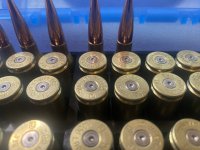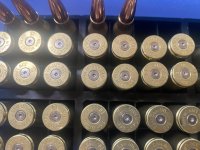A good example is on my 6.5CM. Both of my comp guns that I would use to sling 150gr/153gr bullets thru. I'm at the max book load and maybe a .1 or .2 over. Depends on which book you look at. I have no pressure signs at all anywhere along with normal bolt lift. 150gr bullets at an honest 2700fps give or take a couple of fps. but I in no way will even think about adding another couple of grains of powder to the case.
A strain gauge on the side of the barrel isn't a good way to check for pressure. It's an indicator but not a real accurate one.
In the case of that CM load, I fully agree, but I'm betting you know from reference to published data that your velocity is right up at the top end of where it should be as well. And IMHO, that's a pretty important piece of data.
Now take the exact same load in a different barrel, one where you know the throat is longer for example - and say the velocity is only 2550 fps. Say it's the same barrel length, to make it easy. In that case, IMO it's a pretty safe bet pressure is lower in this second barrel, and within reason it can be safe to increase the load a little to approach that 2700 fps number again. That doesn't mean a good loading practice is "more powder until you hit book velocity"; I'm not saying that at all. But velocity is an important indicator, and IMO a far more reliable indication of relative pressure
with identical components than primer appearance or some other things mentioned in this thread. That's not my own made-up idea either, it's come from several ballisticians who've worked for some of the ammunition manufacturers.
The problem with a strain gauge reading is that you don't have a baseline for reference. (OK, a second problem is frequency of the data aquisition and missing spikes, but that's a separate, and much more nerdy, discussion.) You or I can measure a strain value on our rifles, but we don't have any way to accurately correlate that value to pressure. Since chamber dimensions, temperature, fouling, and all sorts of other things affect pressure, you can't just fire a factory load and say that measurement is max pressure - it most likely may be well under pressure, or in some few cases it might even be over. I've been working hands-on with strain gauge data recording for over 20 years, but this one fact is why I've never bothered with it on my rifles. The value is just very limited.




